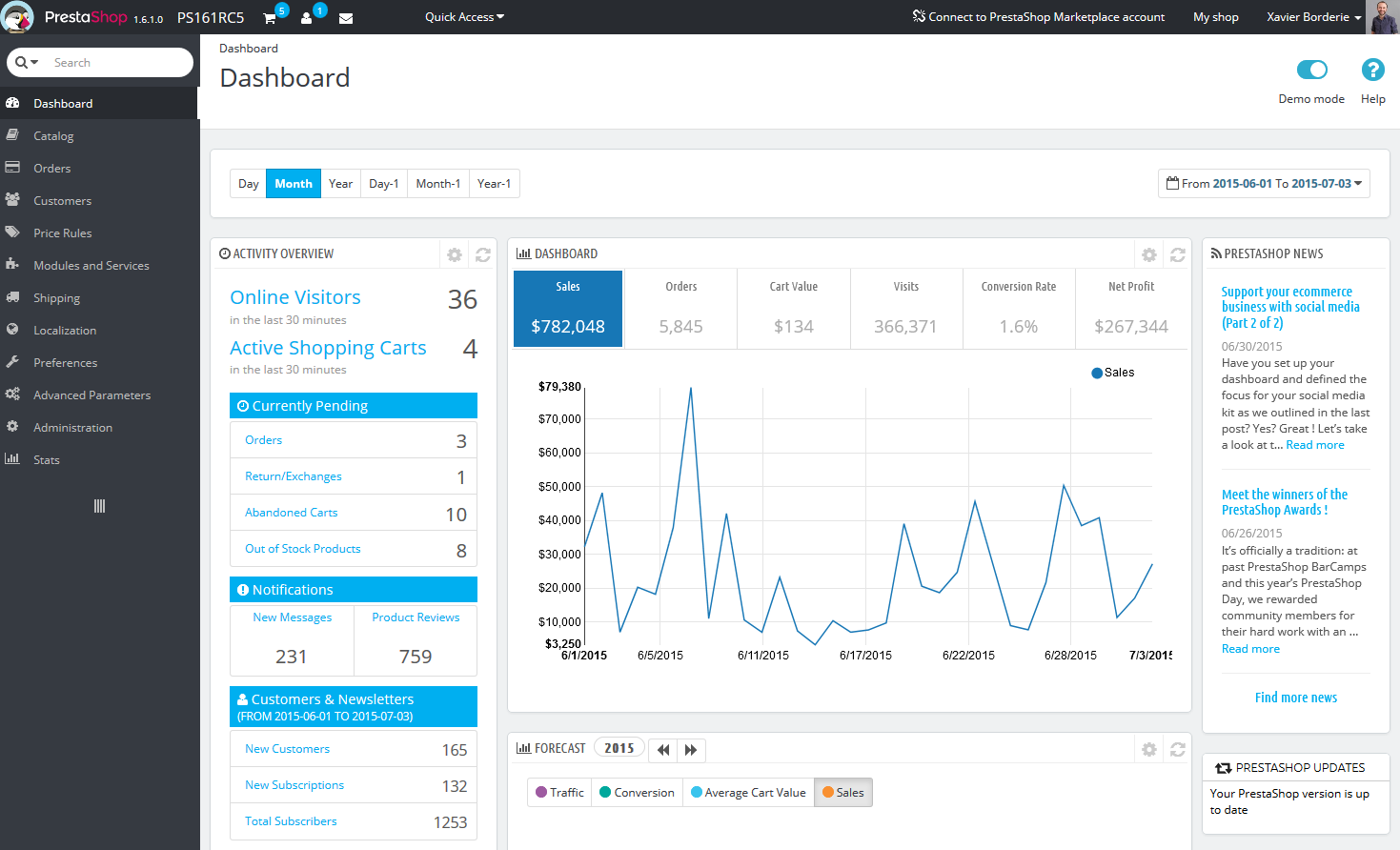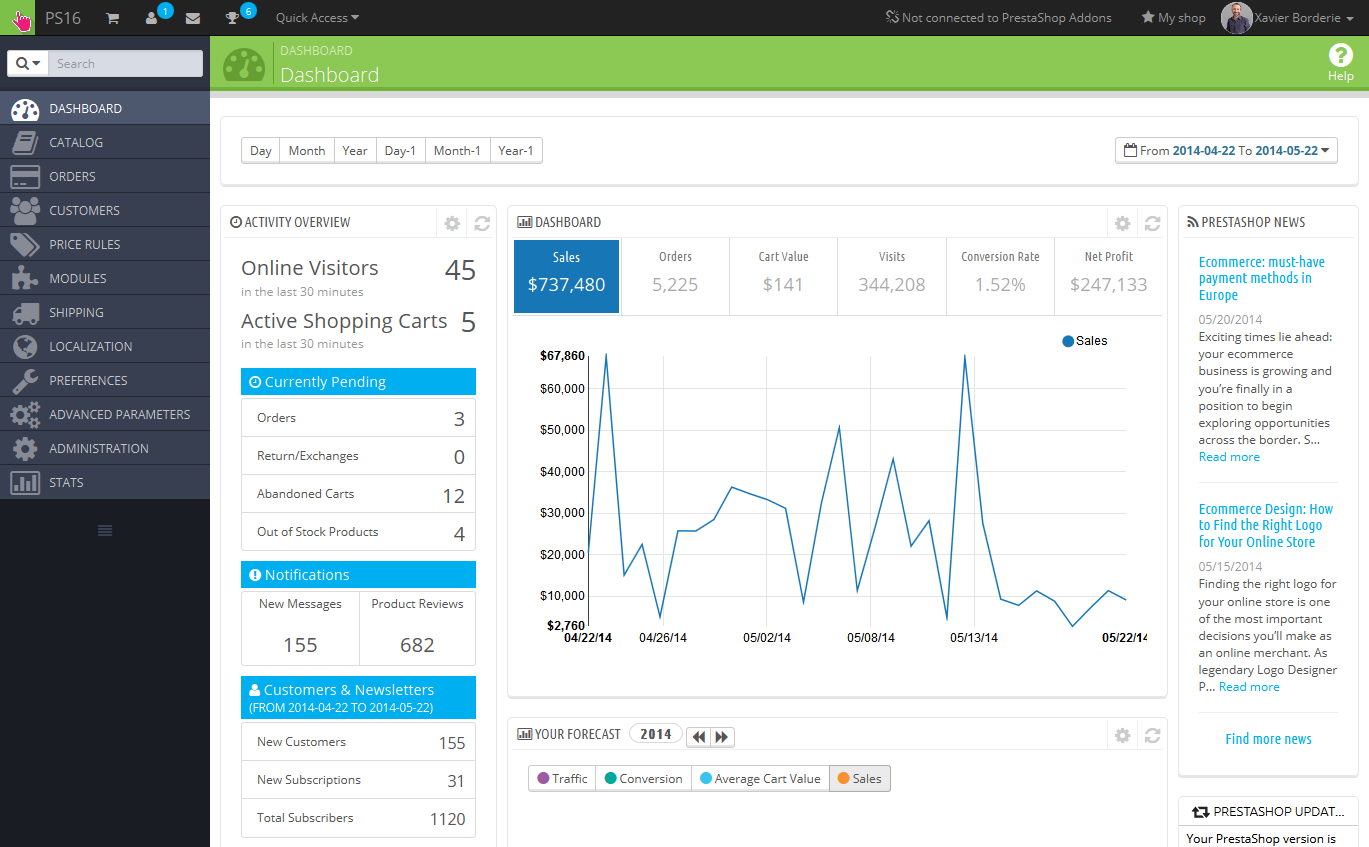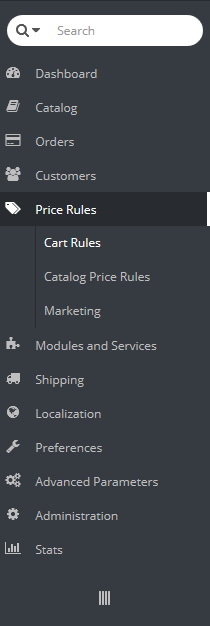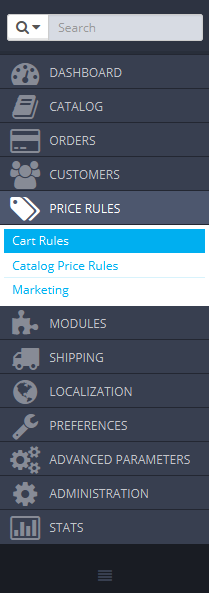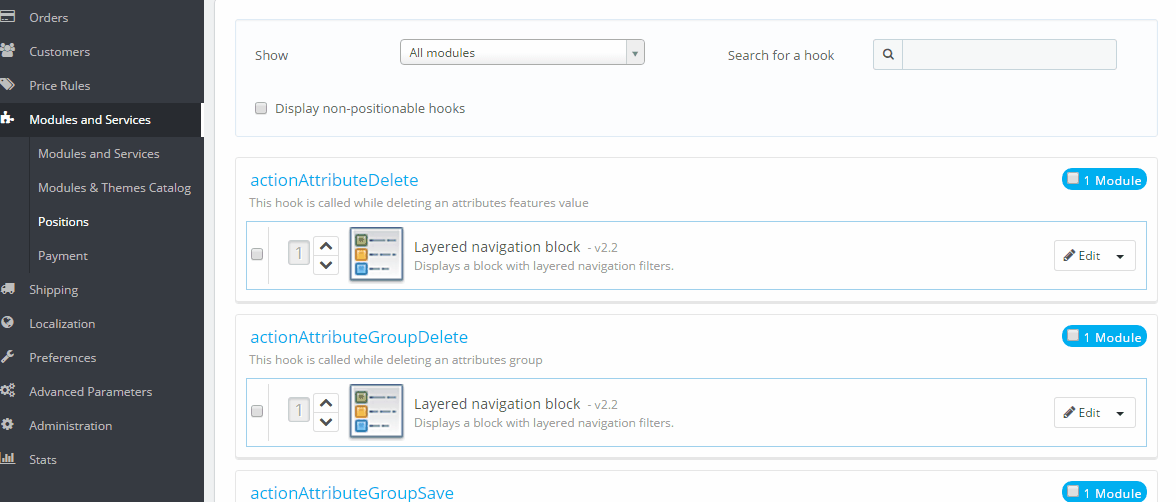...
| Info |
|---|
The design of the administration area has been completely revamped with version 1.6 of PrestaShop in order to be more intuitive and ergonomic – as well as working better on mobile devices. While most of the 1.5 pages and options are still where you can expect them to be, it might take some time to get used to it all |
We have created this chapter in order to help you make the best most of your discovery of PrestaShop's administration interface. It has been designed to be very ergonomic and easy to use, but be aware that you should read the whole guide in order to get a perfect grasp of your new online business tool!
Overview of the main interface
Take the time to survey review the Dashboard – that is, the first page you see when logging into your back - office. Not only does it present you with a summary of everything you need to know about your shop at any given time, along with quick links to the main action page, but as a first-timer in PrestaShop, it also gives you tips about what you should have a look at.
| Info |
|---|
PrestaShop's back office got revamped for version 1.6.1.0, for better readability and ease of use. From version 1.6.0.0 to 1.6.1.0, the back office looked like this: |
The top bar
At the top of the back - office is a black bar containing a handful of information and links:
- (The PrestaShop logo, along with your current version number.
- The name of your shop). From any page, this takes you back to the Dashboard.
- Cart icon. A tooltip indicates the number of new orders, if any. Clicking it opens a panel presenting the new orders since you last clicked that icon. From there on, you can either display one of the new orders, or go to the list of orders.
- Person icon. A tooltip indicates the number of new customers, if any. Clicking it opens a panel presenting the last registered customers. From there on, you can either display one of the new customers, or go to the list of customers.
- Letter icon. A tooltip indicates the number of new messages, if any. Clicking it opens a panel presenting the last customer service message. From there on, you can either display one of the new messages, or go to the list of messages.
- Trophy icon. A tooltip indicates the number of new items, if any. Clicking it opens a panel presenting your progress as a merchant. From there on, you can reach the full page of badges and points, from the "Merchant Expertise" module.
- Quick Access. This is the quick links menu, presenting the most useful links, as set in the "Quick Access" page under the "Administration" menu.
- "Not connected Connect to PrestaShop AddonsMarketplace account" link. Opens a modal window enabling you to connect your shop to the Addons marketplace, and thus get updates from the modules and themes you bought.
- "My Shopshop" link. Opens a new browser tab with your shop's front-end.
- (Personal menu named after your first name ) linkand surname. A simple dropdown panel with a reminder of the administrative account with which you are currently logged-in. It contains the following links:
- "My preferences" link. Takes you to your account's preferences page, where you can set some personal options (for instance, the back-office language or of your back office or your password).
- "Log Sign out" link. Logs you out of the current user account.
...
All along your daily activities administrating your shop, you will have to browse through the many pages and options of the back - office.
| Info |
|---|
By default, the menu system in PrestaShop 1.6 is displayed on the left side of the page. You can switch the menu to the top of the page by using the "Display admin Admin menu orientation" option in your user preference page (which you can access through the link bearing your name in the top bar). In either vertical or horizontal format, the content of each menu is displayed when the mouse hovers the menu label, thus reducing the necessity to load new screens just to access menu options. In addition to that, the vertical format can be minimized to only its icons by clicking on the "parallel lines" icon at the bottom of it. |
Each menu applies to a given set of tasks and contexts:
- Search field with dropdown list. Enables you to search within the content of your shop.
- Dashboard. The homepage of your back office, where you can see the main statistics, live.
- Catalog. This is the heart of your shop, where you will add products, create categories, set up carriers and suppliers, etc.
- Orders. Once clients start adding products in their shopping carts, you will see orders in this menu, with the resulting invoices. This is also where you handle merchandise returns, credit slips and per-order customer service, among other things.
- Customers. Here you can access all the information about your clients, and edit their addresses, create groups of customers to which you can apply special discounts, handle customer service, and even manage social titles if need be.
- Price Rules. A very specific menu, enabling you to easily create vouchers and price reductions through a set of rules.
- Modules and Services. Extend the power and usefulness of your shop by adding and activating modules: more than a hundred are available by default, and many more are available to buy on the Addons marketplace (http://addons.prestashop.com/). This is also where you handle themes, and where you can position the blocks of content from your module on the theme (including the Live Edit feature). One last menu page enables you to apply global settings to payment modules.
- Shipping. Everything pertaining to carriers and shipping costs, as well as marketing.
- Localization. Helps you customize your shop with local values, such as language and translation, currency, units, taxes and tax rules, and geographical entities (regions, countries, etc.).
- Preferences. PrestaShop is a very configurable e-commerce solution, and you can edit just about any of its behaviors using the full-featured preferences.
- Advanced Parameters. This menu contains links to tools and informational pages that are too specific to fit in other menus, such as the Web service settings, the database backup tool, or the performance page, among others.
- Administration. Here are the settings pertaining to the back - office itself; for instance, the content of the Quick Access menu, the employees list and permissions, or the menu order, among others.
- Stats. This menu gives you access to all the numerous statistics and graphics that are gathered and generated by PrestaShop.
...
- Add new. Opens the creation page of the current context: new product, new product category, new order, etc.
- Recommended modulesModules and Services. Open Opens a pop-in window containing the modules available in the current context.
- Help. Opens the online inline documentation for the current page – or "contextual help".
The "Recommended modules" button presents you the modules which apply to the current context. For instance, in the "Shipping > Carriers" page, it will display the modules from the "Shipping & Logistics" category of modules. This is very helpful when you need to quickly find which module to install and configure in order to get a given result.
Many of the back - office forms are validated with buttons at the bottom of the screen:
- Save. Saves the content of the current page and returns to the list of existing items.
- Save and stay. Saves the content of the current page and keep the page open.
- Cancel. Returns to the list of existing items.
Data tables (lists of products, of categories, of customers, etc.) have their own set of buttons to manage the listed items:
- Add new. Creates a new item in the current context.
- Export. Downloads a CSV file of all the items.
- Import. Sends you to the CSV Import option page, from where you can import your CSV files.
- Refresh List. Reloads the list of items to display the latest changes.
- Show SQL Query. Provides the SQL query to reproduce your search or filter in your own SQL manager.
- Export to SQL Manager. Opens PrestaShop's SQL Manager tool (in the "Advanced Parameters") menu, from which you can query PrestaShop's database with SQL statements ("
SELECT ... FROM ... WHERE ...").
If your list of items was filtered (by name, for instance), then the default SQL statement will take this into account (for instance, "WHERE 1 AND b.`name` LIKE '%blouse%'" for product list).
Contextual help
Since version 1.6.0.7 of PrestaShop, the software's documentation is directly embedded into the administration interface: clicking on the "Help" button from any back - office page reduces the main interface's width in order to add a new column on the right, which contains the documentation for that section of the back - office.
Another click on the "Help" button closes the contextual help. If you do not close the help column, PrestaShop understands that you want it displayed on every page of the back - office, and thus will maintain the column open until you have clicked to close it.
...
| Note | ||
|---|---|---|
| ||
By default, the Dashboard uses fake data so that you can better visualize what the various stats are for. When using PrestaShop for a real online store, you must disable this fake data so that your real data is used: click on "No" in deactivate the "Demo mode" block option at the bottom top right of the screen, next to the "Help" icon. |
The horizontal bar
At the top of the Dashboard is a single bar which helps you choose the period of time for the currently displayed dashboard statistics. Three sets of options are available:
...
It also features the "Demo mode" block, from which you can disable the fake data used by default on the Dashboard and use your own data (as gathered by PrestaShop's statistics system).
|
Reorder the elements
On your dashboard, you have the possibility to change the order of the elements displayed on each column (left and center, see above). It is mostly useful if you have additional modules or if you want to focus on some statistics that are not on the first position.
To change the order, please follow these steps:
- Go to Modules & Services / Position page (via your menu)
- Select "Show: All modules"
- Check the "Display non-positionable hooks" checkbox
- In the "Search of a hook" field, enter "dashboardZoneOne" for the left column, or "dashboardZoneTwo" for the right column.
Now you see all the elements hooked on the left/center columns.
To change the positions, you can drag and drop them or you can click on the small arrow close to the module logos, as shown below :
